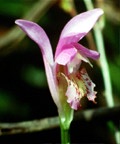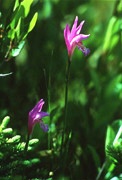Arethusa bulbosa L.
Dragon-mouth
This monotypic genus is named after a beautiful Greek nymph, rather appropriate
given the beauty of the flower. The specific epithet bulbosa is the
Latin meaning "bulbed," in reference to the small pseudobulb of
this species. Arethusa bulbosa is closely related to Eleorchis
japonica of Japan; historically E. japonica had been treated
as Arethusa japonica.


DESCRIPTION: Plant
arising from a small, round corm rather loosely attached to the substrate
in which is growing (typically Sphagnum). One leaf, grass-like,
4-20 cm long and 3-12 mm wide, reduced or absent at flowering time, developing
more fully later in the season. Flower typically one (rarely two)
located at the terminus of a stalk ranging from 10-40 cm long, subtended
by a bract 2-4 mm long and about 2 mm wide. Sepals oblanceolate,
2-4 cm long and 4-9 mm wide, bright magenta to pinkish white, rarely white;
forming an erect hood or backing to the rest of the flower. Petals
oblanceolate, 2-3 cm long and 3-8 mm wide, closely appressed to the column,
colored as sepals. Labellum obovate, 20-25 mm long and 12-15 mm wide,
whitish pink to white in the center with a suffusion of yellow and spotted
with deep magenta, margin pink; center of the labellum bearing numerous
yellowish hairs.
SIMILAR SPECIES: The plants are difficult to identify unless flowering,
but then they can be confused with little else. Two slightly similar species
that grow in the same habitat and flower at about the same time are Calopogon
tuberosus and Pogonia ophioglossoides.
HABITAT: Arethusa is almost always found in acidic,
boggy conditions, typically growing from Sphagnum moss. In Wisconsin
it can be most commonly found growing in floating mat bogs ringing northern
lakes.
FLOWERING DATES: June 1 to July 10.
POLLINATION: The flowers of Arethusa offer little or no nectar
reward to their pollinators, even though they are attractively colored and
sweetly scented. They apparently deceive their pollinators, inexperienced
queen bumblebees, by supplying all the cues of a rewarding flower without
the rewards. The bees quickly learn to avoid the flowers, however, so pollination
is dependent on an adequate supply of recently-emerged inexperienced bumblebees.
This may place constraints on the phenology of flowering. For a detailed
discussion of the pollination of Arethusa, see Thien
& Marcks' 1972 paper.
DISCUSSION: Arethusa is perhaps the most beautiful flower
in the North American flora (but its a close competition with another orchid,
Calypso bulbosa). Numerous authors have
waxed eloquent about the beauty, and I doubt I can add to their accolades.
Unfortunately, this extreme beauty has led to a high desirability for collection,
and many populations have been depleted or destroyed by overcollection.
Since the plants don not typically persist very long, collection from the
wild is unwise. Recently some success has been had in culturing and hybridizingArethusa.
For more information, see Carson
Whitlow's Cyp Haven home page. According to Luer
(1975), early americans used the corms of Arethusa as a remedy
for toothaches.
WI DISTRIBUTION:  U.S. DISTRIBUTION:
U.S. DISTRIBUTION:
Go directly to Wisconsin herbarium records.
Return
to the main LIST of the Orchids of Wisconsin.
Return to the main KEY to the Orchids of
Wisconsin.


 U.S. DISTRIBUTION:
U.S. DISTRIBUTION: